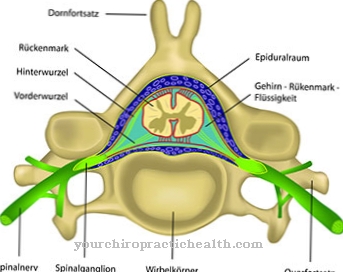Pneumonia, or pneumonia, is a serious disease. With such a disease, the lung tissue is acutely inflamed. Chronic forms are also not uncommon. The Bronchopneumonia is a special form of common pneumonia.
What is bronchopneumonia?

© Reing - stock.adobe.com
Bronchopneumonia is the most common type of pneumonia. The doctor speaks of a morphological form of the course of pneumonia.
The description of the disease is determined by the exact location of the event, because the inflammation initially affects the bronchi. The trachea divides into two branches, the bronchi. These then branch out into smaller branches until they end in the alveoli, the alveoli. The exchange of gases takes place in these alveoli when inhaling and exhaling.
The inflammation is focal, with the inflammation foci of different sizes and located in the vicinity of the bronchi. The inflammation spreads and travels from the bronchi to the lungs.
causes
The causes of bronchopneumonia are varied. Bronchopneumonia often develops from bronchitis, an inflammation of the bronchi. In most cases, infection occurs through the air.
Inhaling pathogens, such as the flu virus, can also lead to pneumonia. If the defenses of the lungs are disturbed and weakened, the penetration of bacteria and viruses, but also of fungi and parasites, is made easier.
Allergies can also be the trigger for pneumonia.The bronchi rarely become inflamed, followed by pneumonia due to the inhalation of irritants or toxins. In the elderly or children, swallowed objects or particles from food can also cause inflammation.
Symptoms, ailments & signs
In bronchopneumonia, those affected suffer from various breathing and lung problems. In the worst case, this can lead to death or permanent damage to the body if the disease is not treated properly. First and foremost, the patients suffer from a strong cough that is associated with sputum.
This has a negative effect on the patient's quality of life and can also lead to restrictions in everyday life. It can also lead to a high fever and a general feeling of illness, with those affected also suffering from tiredness or fatigue. These symptoms cannot be compensated for by sleep.
Since bronchopneumonia also leads to an insufficient supply of oxygen to the body, the skin can turn blue and the internal organs or even the brain can be damaged. This damage is usually not treatable. Furthermore, abnormal breathing noises occur, which can lead to sleep problems or complications with one's own partner.
In some cases, the disease also causes chest pain, cramps, or even vomiting. If bronchopneumonia is not treated, it can also lead to a reduced life expectancy for the patient.
Diagnosis & course
In order to determine with certainty whether a patient has bronchopneumonia, the doctor will first take a medical history. Above all, however, he asks about the current complaints. He will listen carefully to the patient with the stethoscope.
In most cases he will be able to determine whether there is inflammation of the lungs. The examination of the sputum and an X-ray could lead to a reliable diagnosis in doubtful cases. A blood gas analysis and a lung function test can also provide information about the extent of the inflammation.
The symptoms of bronchopneumonia are initially fever, cough, and sputum. If the disease is severe, it can also cause shortness of breath. If bacteria are the cause of the inflammation, the disease is quite severe. The fever rises rapidly and the general condition is severely deteriorated.
This can even lead to a lack of oxygen with a bluish discoloration of the lips, fingers and toes. In viral pneumonia, the symptoms are less pronounced. The general condition is only slightly affected. In children, bronchopneumonia can present with vomiting, cramps, and chest pain.
Complications
As a result of bronchopneumonia, patients suffer from severe lung complaints that resemble pneumonia. Loud and abnormal breathing noises occur, which are also related to shortness of breath. Often the patients suffer from panic attacks when they are short of breath. The bronchopneumonia also leads to a fever and a general feeling of illness.
The person affected is no longer able to cope with everyday life in the usual way. The lips often turn blue and there is vomiting and chest pain. The fever in bronchopneumonia is relatively high and can only be treated with bed rest. Typically, during treatment, the patient increases an antibiotic and other medications to help loosen the mucus.
Complications can arise especially if the bronchopneumonia is not treated or if the patient does not allow the body to recover during the illness. The breathing difficulties and the high fever can lead to a life-threatening condition, especially in older people. If the bronchopneumonia is treated and heals, there will usually be no further symptoms.
When should you go to the doctor?
Since bronchopneumonia is a very serious and still life-threatening disease, a doctor should definitely be consulted. Self-healing does not occur with this disease, so a visit to the doctor is essential. A doctor must be consulted, especially in the case of persistent coughing with sputum. Bronchopneumonia is manifested by shortness of breath and, in many cases, by fever.
If these symptoms do not go away with a common cold, a doctor must be consulted. Likewise, abnormal breathing sounds can indicate bronchopneumonia and must be examined. The breathing difficulties can also lead to tiredness, fatigue and blue discoloration of the patient's lips and skin. Bronchopneumonia can be diagnosed and treated by a general practitioner or by an ENT doctor or pulmonologist. In acute emergencies, an emergency doctor should be called or the hospital should be visited.
Doctors & therapists in your area
Treatment & Therapy
To combat bronchopneumonia, the doctor will first order general measures. Bed rest, light food and, above all, adequate intake of fluids form the basis for a quick recovery. Inhalations can also support the healing process. Breathing exercises and tapping massages also help promote healing. If you are short of breath, the supply of oxygen can be helpful.
However, these general measures will not be sufficient. A broad spectrum antibiotic is used for bacterial bronchopneumonia. If the pathogen is detected, a special antibiotic can be given. In addition, drugs can be used to dissolve mucus or, if the fever is high, also antipyretic drugs. Because antibiotics are not effective against viruses, they are not used in virus-induced inflammation. Their use as a prevention against bacterial superinfection in pneumonia is controversial.
Outlook & forecast
In most cases, bronchopneumonia can be treated relatively well. The disease usually progresses positively, especially with early diagnosis. If there is no treatment, those affected suffer from a significant lack of oxygen and thus also from a blue coloration of the skin and lips. The internal organs can also be damaged if the oxygen supply is also interrupted.
As a result of bronchopneumonia, children suffer from cramps, vomiting and severe chest pain. Self-healing does not occur, and the inflammation continues to spread. People generally feel tired and exhausted.
Treatment of bronchopneumonia in most cases leads to a positive course and complete cure relatively quickly. Taking antibiotics completely alleviates the symptoms. Since bronchopneumonia can also be associated with fever, antipyretic drugs are also necessary. There are no particular complications or side effects. Additional bed rest will speed recovery. After the treatment there are no further restrictions in the patient's life.
prevention
The best prevention is to protect yourself from infection. Above all, you should avoid contact with people who are already sick. The vaccination against the flu, which can cause bronchopneumonia, is mainly for older people and people with previous illnesses and chronic diseases (diabetes, cardiovascular diseases or AIDS) should be vaccinated.
Aftercare
In the case of bronchopneumonia, follow-up care is not always absolutely necessary, but it always has a positive effect on the course of the disease and can avoid further complications. With this disease, the person affected should definitely refrain from strenuous activities and sporting activities. In general, the lungs need to recover from bronchopneumonia.
The patient must not smoke under any circumstances and should follow a healthy lifestyle with a healthy diet. In some cases, however, artificial ventilation using oxygen is necessary. After the illness, you should also take antibiotics and other medication.
The antibiotics must not be taken with alcohol, and the patient should also be aware of the interaction with other drugs. These can be discussed with the attending physician. Breathing exercises can also accelerate healing and have a positive effect on the course of the disease.
These exercises can often be done at home. The person concerned should also ensure that there is an adequate supply of fluids. Usually, there is complete healing without permanent damage. In the case of psychological complaints or depression, a psychologist can also be consulted.
You can do that yourself
Since bronchopneumonia is a serious disease of the bronchi and lungs, it should never be treated like a common cold itself. Therapy must be carried out under medical supervision in order to prevent serious and permanent damage to health. However, patients can do a lot to alleviate the symptoms and shorten the course of the disease.
For the latter, it is imperative that those affected strictly follow the doctor's instructions if the doctor has given him bed rest or at least a work ban. Overexertion or (renewed) hypothermia from being outdoors can significantly delay the recovery process. The recovery process is supported by sufficient fluid intake, a light, vitamin-rich vegetarian or vegan diet and plenty of sleep. On the other hand, patients should definitely avoid stress.
One of the symptoms that is almost always associated with bronchopneumonia is a strong cough, often with slimy or bloody sputum. In addition to the medically prescribed medication, there are also some home remedies to improve the situation. Sage products, which are available as candies, drops or tea, soothe the urge to cough and have an expectorant and astringent effect. Nasal rinsing with salt water keep the entire ear, nose and throat area moist and counteract the colonization of the affected areas with bacteria. If the fever is high, calf compresses or cold baths help. The latter, however, are not suitable for patients with an unstable circulation.












.jpg)



.jpg)










.jpg)
